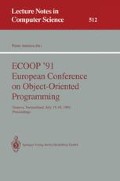Abstract
The benefits of computational reflection are the abilities to reason and alter the dynamic behavior of computation from within the language framework. This is more beneficial in concurrent/distributed computing, where the complexity of the system is much greater compared to sequential computing; we have demonstrated various benefits in our past research of Object-Oriented Concurrent Reflective (OOCR) architectures. Unfortunately, attempts to formulate reflective features provided in practical reflective systems, such as resource management, have led to some difficulties in maintaining the linguistic lucidity necessary in computational reflection. The primary reason is that previous OOCR architectures lack the ingredients for group-wide object coordination. We present a new OOCR language with a hybrid group reflective architecture, ABCL/R2, whose key features are the notion of heterogeneous object groups and coordinated management of group shared resources. We describe and give examples of how such management can be effectively modeled and adaptively modified/controlled with the reflective features of ABCL/R2. We also identify that this architecture embodies two kinds of reflective towers, individual and group.
Preview
Unable to display preview. Download preview PDF.
References
Gul Agha. ACTORS: A Model of Concurrent Computation in Distributed Systems. The MIT Press, 1986.
Christopher Burdorf and Jed Marti. Non-preemptive time warp scheduling algorithm. Operating Systems Review, 24(2):7–18, April 1990.
Andrew Chien and William J. Dally. Concurrent aggregates. In Proceedings of ACM SIGPLAN Symposium on Principles and Practice of Parallel Programming (PPOPP), pages 187–196. SIGPLAN Notices, March 1990.
Olivier Danvy and Karoline MalmkjÆr. Intensions and extensions in the reflective tower. In Proceedings of the ACM Conference on LISP and Functional Programming, pages 327–341. ACM Press, 1988.
Jacques Ferber. Conceptual reflection and Actor languages. In Pattie Maes and Daniele Nardi, editors, Meta-Level Architectures and Reflection, pages 177–193. North-Holland, 1988.
Jacques Ferber. Computational reflection in class-based object-oriented languages. In Proceedings of OOPSLA'89, volume 24, pages 317–326. SIGPLAN Notices, ACM Press, October 1989.
David R. Jefferson. Virtual Time. ACM Transactions on Programming Languages and Systems, 7(3):404–425, July 1985.
Luping Liang, Samuel T. Chanson, and Gerald W. Newfeld. Process groups and group communications: Classifications and requirements. IEEE Computer, pages 56–66, February 1990.
Pattie Maes. Concepts and experiments in computational reflection. In Proceedings of OOPSLA'87, volume 22, pages 147–155. SIGPLAN Notices, ACM Press, October 1987.
Pattie Maes. Issues in computational reflection. In Pattie Maes and Daniele Nardi, editors, Meta-Level Architectures and Reflection, pages 21–35. North-Holland, 1988.
Satoshi Matsuoka and Akinori Yonezawa. Metalevel solution to inheritance anomaly in concurrent object-oriented languages. In Proceedings of the ECOOP/OOPSLA '90 Workshop on Reflection and Metalevel Architectures in Object-Oriented Programming, October 1990.
Flavio De Paoli and Mehdi Jazayeri. FLAME: a language for distributed programming. In Proceedings of the 1990 IEEE International Conference on Programming Languages, pages 69–78, 1990.
Ramana Rao. Implementational reflection in Silica. In Proceedings of ECOOP'91. Springer-Verlag, July 1991.
Brian C. Smith. Reflection and semantics in Lisp. In Conference Record of the ACM Symposium on Principles of Programming Languages, pages 23–35. ACM Press, 1984.
Brian C. Smith. What do you mean, meta? In Proceedings of the ECOOP/OOPSLA '90 Workshop on Reflection and Metalevel Architectures in Object-Oriented Programming, October 1990.
Tomoyuki Tanaka. Actor-based reflection without meta-objects. Technical Report RT-0047, IBM Research, Tokyo Reserach Laboratory, August 1990.
Tomoyuki Tanaka and Shigeru Uzuhara. Multiprocessor Common Lisp on TOP-1. In Proceedings of the IEEE Symposium on Parallel and Distributed Processing, 1990. (to appear).
Frank van Harmlen. A classification of meta-level architectures. In Abramson and Rogers, editors, Meta-Programming in Logic Programming, chapter 5, pages 103–122. The MIT Press, 1989.
Mitchell Wand and Danel P. Friedman. The mystery of the tower revealed: A non-reflective description of the reflective tower. In Pattie Maes and Daniele Nardi, editors, Meta-Level Architectures and Reflection, pages 111–134. North-Holland, 1988.
Takuo Watanabe and Akinori Yonezawa. Reflection in an object-oriented concurrent language. In Proceedings of OOPSLA '88, volume 23, pages 306–315. SIGPLAN Notices, ACM Press, September 1988.
Takuo Watanabe and Akinori Yonezawa. An actor-based metalevel architecture for group-wide reflection. In Proceedings of the REX School/Workshop on Foundations of Object-Oriented Languages (REX/FOOL), Noordwijkerhout, the Netherlands, Lecture Notes in Computer Science. Springer-Verlag, May 1990.
Yasuhiko Yokote, Fumio Teraoka, and Mario Tokoro. A reflective architecture for an object-oriented distributed operating system. In Stephen Cook, editor, Proceedings of ECOOP'89, pages 89–106. Cambridge University Press, 1989.
Akinori Yonezawa, editor. ABCL: An Object-Oriented Concurrent System. Computer Systems Series. The MIT Press, 1990.
Akinori Yonezawa and Takuo Watanabe. An introduction to object-based reflective concurrent computations. In Proceedings of the 1988 ACM SIGPLAN Workshop on Object-Based Concurrent Programming, volume 24, pages 50–54. SIGPLAN Notices, ACM Press, April 1989.
Author information
Authors and Affiliations
Editor information
Rights and permissions
Copyright information
© 1991 Springer-Verlag Berlin Heidelberg
About this paper
Cite this paper
Matsuoka, S., Watanabe, T., Yonezawa, A. (1991). Hybrid group reflective architecture for object-oriented concurrent reflective programming. In: America, P. (eds) ECOOP'91 European Conference on Object-Oriented Programming. ECOOP 1991. Lecture Notes in Computer Science, vol 512. Springer, Berlin, Heidelberg. https://doi.org/10.1007/BFb0057025
Download citation
DOI: https://doi.org/10.1007/BFb0057025
Published:
Publisher Name: Springer, Berlin, Heidelberg
Print ISBN: 978-3-540-54262-9
Online ISBN: 978-3-540-47537-8
eBook Packages: Springer Book Archive

